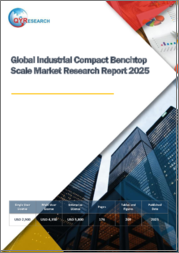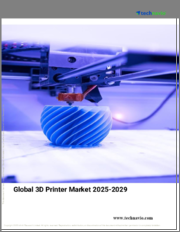
|
시장보고서
상품코드
1621743
다이 커팅 서비스 시장 성장 기회, 성장 촉진요인, 산업 동향 분석 및 예측(2024-2032년)Die-Cutting Service Market Opportunity, Growth Drivers, Industry Trend Analysis, and Forecast 2024 - 2032 |
||||||
세계 다이 커팅 서비스 시장은 2023년 20억 달러로 평가되었고, 2024년부터 2032년까지 연평균 3.8% 성장할 것으로 예상됩니다.
포장, 자동차, 섬유, 전자, 의료 등 다양한 산업 분야에서 다이 커팅 서비스에 크게 의존하고 있습니다. 이러한 광범위한 사용으로 인해 이러한 부문의 기업들은 맞춤형 형태와 디자인을 만드는 효율적인 방법을 찾고 있으며, 다이 커팅 솔루션에 대한 안정적인 수요를 보장하고 있습니다. 다이 커팅은 제품을 보호할 뿐만 아니라 미적 매력을 더하는 포장재 제조에 중요한 역할을 하고 있습니다. 다이 커팅 사업을 시작하려면 기계와 기술에 대한 막대한 투자가 필요하기 때문에 시장 진입을 원하는 중소기업과 신생 기업에게는 장벽이 될 수 있습니다.
또한, 3D 프린팅과 같은 대체 제조 기술의 등장은 전통적인 다이 커팅 산업에 도전이 되고 있습니다. 복잡한 디자인을 보다 빠르고 효율적으로 제조할 수 있기 때문에 일부 기업들은 이러한 신기술을 선택할 것으로 보입니다. 이 시장은 공정 유형별로 구분할 수 있으며, 2023년 시장 점유율은 다이 커팅이 약 44%를 차지할 것으로 예상됩니다. 이 부문은 2032년까지 연평균 4%의 성장률을 보일 것으로 예상됩니다. 다이 커팅은 고속으로 작동하기 때문에 대량의 다이 커팅 제품을 효율적으로 생산할 수 있습니다. 이 능력은 포장 및 인쇄와 같이 빠른 배송이 필요한 부문에서 특히 매력적입니다.
또한, 다이 커팅이 제공하는 정밀도와 균일성은 대량 생산 시에도 일관된 커팅이 보장되기 때문에 규격에 대한 엄격한 준수가 요구되는 응용 분야에 필수적입니다. 최종 용도별로는 포장 부문이 2023년 약 52% 시장 점유율을 차지할 것으로 예상되며, 2032년에는 53%까지 증가할 것으로 전망됩니다. 포장은 마케팅과 브랜딩에서 중요한 역할을 하고 있으며, 아디컷팅은 매장과 온라인 모두에서 소비자의 관심을 끌 수 있는 복잡한 형태와 혁신적인 디자인을 만들 수 있습니다. 골판지부터 플라스틱까지 다양한 재료를 다룰 수 있기 때문에 제조업체는 다양한 산업의 다양한 포장 요구를 충족시킬 수 있습니다. 아시아태평양은 2023년 다이 커팅 서비스 시장의 약 36%를 차지할 것으로 예상되며, 2032년에는 10억 달러에 달할 것으로 전망됩니다. 이 지역은 여러 부문에서 산업화가 빠르게 진행되고 있어 효율적인 생산 방식에 대한 수요가 증가하고 있습니다.
| 시장 범위 | |
|---|---|
| 시작 연도 | 2023년 |
| 예측 연도 | 2024년-2032년 |
| 시작 금액 | 20억 달러 |
| 예상 금액 | 2.7억 달러 |
| CAGR | 3.8% |
제조업체들이 부품 및 포장 공정을 최적화하기 위해 노력함에 따라 다이 커팅 서비스가 점점 더 중요해지고 있습니다. 이 지역은 포장 시장이 강세를 보이고 있으며, 다재다능하고 지속 가능한 포장 솔루션에 대한 요구로 인해 효율성과 창의적인 디자인을 모두 향상시키는 다이 커팅 서비스에 대한 수요가 증가하고 있습니다.
목차
제1장 조사 방법과 조사 범위
제2장 주요 요약
제3장 산업 인사이트
- 생태계 분석
- 밸류체인에 영향을 미치는 요인
- 이익률 분석
- 변혁
- 향후 전망
- 제조업체
- 유통업체
- 소매업체
- 주요 뉴스와 이니셔티브
- 규제 상황
- 영향요인
- 성장 촉진요인
- 자동차 산업 확대
- 전산업 수요 증가
- 산업 잠재적 리스크와 과제
- 높은 초기 투자
- 성장 촉진요인
- 성장 가능성 분석
- Porter's Five Forces 분석
- PESTEL 분석
제4장 경쟁 구도
- 서론
- 기업 점유율 분석
- 경쟁 포지셔닝 매트릭스
- 전략 전망 매트릭스
제5장 시장 추정·예측 : 프로세스 유형별, 2021-2032년
- 주요 동향
- 로터리형 빼기
- 플랫베드형 빼기
- 디지털 형 빼기
- 워터젯 형 빼기
- 기타(레이저 형 빼기 등)
제6장 시장 추정·예측 : 재료별, 2021-2032년
- 주요 동향
- 종이·골판지
- 플라스틱·필름
- 고무
- 발포스티롤
- 금속 시트
- 기타(피혁 등)
제7장 시장 추정·예측 : 최종 용도별, 2021-2032년
- 주요 동향
- 포장
- 자동차
- 일렉트로닉스
- 의료
- 기타(항공우주, 소비재 등)
제8장 시장 추정·예측 : 지역별, 2021-2032년
- 주요 동향
- 북미
- 미국
- 캐나다
- 유럽
- 영국
- 독일
- 프랑스
- 이탈리아
- 스페인
- 아시아태평양
- 중국
- 인도
- 일본
- 한국
- 인도네시아
- 말레이시아
- 라틴아메리카
- 브라질
- 멕시코
- 중동 및 아프리카
- 남아프리카공화국
- 사우디아라비아
- 아랍에미리트
제9장 기업 개요
- American Industrial Company
- Baril Corporation
- Bernard Group
- Colvin-Friedman Company
- Custom Fabricating & Supplies, Inc.
- Eurolaser
- Gardico Inc
- Heubach Corporation
- The Strouse Corporation
- Thrust Industries
The Global Die-Cutting Service Market was valued at USD 2 billion in 2023 and is projected to grow at a CAGR of 3.8% from 2024 to 2032. Various industries, including packaging, automotive, textiles, electronics, and healthcare, heavily rely on die-cutting services. This widespread usage ensures a consistent demand for die-cutting solutions as businesses across these sectors seek efficient methods to create custom shapes and designs. The rapid expansion of e-commerce has further amplified the need for innovative and visually appealing packaging solutions, with die-cutting playing a crucial role in producing packaging that not only protects products but also enhances their aesthetic appeal. Launching a die-cutting operation requires a significant investment in machinery and technology, which can be a barrier for small businesses and startups looking to enter the market.
In addition, the rise of alternative manufacturing technologies, such as 3D printing, challenges the traditional die-cutting industry. Some companies may opt for these newer technologies due to their ability to produce complex designs more rapidly and efficiently. The market can be segmented by process type, with rotary die-cutting accounting for about 44% of the market share in 2023. This segment is expected to grow at a CAGR of 4% through 2032. Rotary die-cutting operates at high speeds, allowing for the efficient production of large quantities of die-cut products. This capability is particularly appealing in sectors that require quick turnaround times, such as packaging and printing.
Furthermore, the precision and uniformity offered by rotary die-cutting ensure consistent cuts across large batches, which is essential for applications that require strict adherence to specifications. In terms of end-use, the packaging segment dominated the market with approximately 52% share in 2023, projected to increase to 53% by 2032. Packaging plays a vital role in marketing and branding, and Adie-cutting enables the creation of intricate shapes and innovative designs that attract consumer attention both in stores and online. The ability to work with a wide range of materials, from cardboard to plastic, allows manufacturers to meet diverse packaging needs across various industries. The Asia Pacific region held around 36% of the die-cutting service market in 2023 and is expected to reach USD 1 billion by 2032. Rapid industrialization across several sectors in this region drives the demand for efficient production methods.
| Market Scope | |
|---|---|
| Start Year | 2023 |
| Forecast Year | 2024-2032 |
| Start Value | $2 Billion |
| Forecast Value | $2.7 Billion |
| CAGR | 3.8% |
As manufacturers seek to optimize their processes for components and packaging, die-cutting services become increasingly essential. The region is strong in the packaging market, with the need for versatile and sustainable packaging solutions fueling demand for die-cutting services that enhance both efficiency and creative design.
Table of Contents
Chapter 1 Methodology & Scope
- 1.1 Market scope & definitions
- 1.2 Research design
- 1.2.1 Research approach
- 1.2.2 Data collection methods
- 1.3 Base estimates & calculations
- 1.3.1 Base year calculation
- 1.3.2 Key trends for market estimation
- 1.4 Forecast model
- 1.4.1 Primary research and validation
- 1.4.2 Primary sources
- 1.4.3 Data mining sources
Chapter 2 Executive Summary
- 2.1 Industry 360° synopsis, 2021-2032
Chapter 3 Industry Insights
- 3.1 Industry ecosystem analysis
- 3.1.1 Factors affecting the value chain
- 3.1.2 Profit margin analysis
- 3.1.3 Disruptions
- 3.1.4 Future outlook
- 3.1.5 Manufacturers
- 3.1.6 Distributors
- 3.1.7 Retailers
- 3.2 Key news & initiatives
- 3.3 Regulatory landscape
- 3.4 Impact forces
- 3.4.1 Growth drivers
- 3.4.1.1 Expansion of the automotive sector
- 3.4.1.2 Rising demand across industries
- 3.4.2 Industry pitfalls & challenges
- 3.4.2.1 High initial investment
- 3.4.1 Growth drivers
- 3.5 Growth potential analysis
- 3.6 Porter's analysis
- 3.7 PESTEL analysis
Chapter 4 Competitive Landscape, 2023
- 4.1 Introduction
- 4.2 Company market share analysis
- 4.3 Competitive positioning matrix
- 4.4 Strategic outlook matrix
Chapter 5 Market Estimates & Forecast, By Process Type, 2021-2032 (USD Billion)
- 5.1 Key trends
- 5.2 Rotary die cutting
- 5.3 Flatbed die cutting
- 5.4 Digital die cutting
- 5.5 Waterjet die cutting
- 5.6 Others (Laser Die Cutting, Etc)
Chapter 6 Market Estimates & Forecast, By Material, 2021-2032 (USD Billion)
- 6.1 Key trends
- 6.2 Paper & cardboard
- 6.3 Plastics & films
- 6.4 Rubber
- 6.5 Foam
- 6.6 Metal sheets
- 6.7 Others (Leather, Etc)
Chapter 7 Market Estimates & Forecast, By End Use, 2021-2032 (USD Billion) (Million Units)
- 7.1 Key trends
- 7.2 Packaging
- 7.3 Automotive
- 7.4 Electronics
- 7.5 Medical & healthcare
- 7.6 Others (Aerospace, Consumer Goods, Etc)
Chapter 8 Market Estimates & Forecast, By Region, 2021-2032 (USD Billion) (Million Units)
- 8.1 Key trends
- 8.2 North America
- 8.2.1 U.S.
- 8.2.2 Canada
- 8.3 Europe
- 8.3.1 UK
- 8.3.2 Germany
- 8.3.3 France
- 8.3.4 Italy
- 8.3.5 Spain
- 8.4 Asia Pacific
- 8.4.1 China
- 8.4.2 India
- 8.4.3 Japan
- 8.4.4 South Korea
- 8.4.5 Indonesia
- 8.4.6 Malaysia
- 8.5 Latin America
- 8.5.1 Brazil
- 8.5.2 Mexico
- 8.6 MEA
- 8.6.1 South Africa
- 8.6.2 Saudi Arabia
- 8.6.3 UAE
Chapter 9 Company Profiles
- 9.1 American Industrial Company
- 9.2 Baril Corporation
- 9.3 Bernard Group
- 9.4 Colvin-Friedman Company
- 9.5 Custom Fabricating & Supplies , Inc.
- 9.6 Eurolaser
- 9.7 Gardico Inc
- 9.8 Heubach Corporation
- 9.9 The Strouse Corporation
- 9.10 Thrust Industries



















